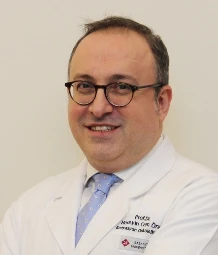Main Session

Sep
30
PQA 07 - Genitourinary Cancer, Patient Safety, Nursing/Supportive Care
3308 - Late Genitourinary Toxicity in Prostate Cancer Patients with PRIOR Transurethral Resection of the Prostate: A Comparative Analysis of Radiotherapy with vs. without Simultaneous Integrated BOOST
Presenter(s)

Huseyin Cem Onal, MD - Baskent University Faculty of Medicine, Adana, Yuregir
H. C. Onal1,2, O. C. C. Guler2, B. Demirhan3, A. Elmali1, and M. N. Yavuz1; 1Baskent University Faculty of Medicine, Department of Radiation Oncology, Ankara, Turkey, 2Baskent University Faculty of Medicine, Adana Dr Turgut Noyan Research and Treatment Center, Department of Radiation Oncology, Adana, Turkey, 3Iskenderun Gelisim Hospital, Hatay, Turkey
Purpose/Objective(s):
This study aimed to evaluate late genitourinary (GU) toxicity in prostate cancer (PCa) patients with a history of transurethral resection of the prostate (TUR-P) who were treated with radiotherapy (RT) delivered either by standard technique or with a simultaneous integrated boost (SIB) to an intraprostatic lesion (IPL). Additionally, we sought to identify factors predictive of late grade =2 and =3 GU toxicities.Materials/Methods:
We retrospectively reviewed data from 207 PCa patients treated between September 2011 and July 2024. Patients received either standard RT (sRT) at 78 Gy in 39 fractions or radiotherapy with SIB, delivering up to 86 Gy in 39 fractions to IPL. Late urinary toxicity was assessed at a minimum of 6 months post-RT and graded according to the Common Terminology Criteria for Adverse Events (CTCAE) version 5.0, using a prospectively maintained institutional database. Uni- and multivariable binary logistic regression analyses were conducted to evaluate the impact of SIB and other potential factors on the cumulative incidence of late grade =2 and =3 GU toxicities.Results:
Of the 207 patients, 98 (47.3%) received SIB and 109 (52.7%) underwent sRT. Baseline characteristics were comparable between the two groups, except for risk group distribution; the sRT group had a significantly higher proportion of high-risk patients than the SIB group (67.0% vs. 51.2%, p = 0.007). The median interval from TUR-P to RT was 6 months (range, 3–138 months) with no significant difference between the sRT (7 months) and SIB (5 months) groups (p = 0.41). With a median follow-up of 107 months (interquartile range [IQR], 94–120 months), the cumulative rates of late grade 2 and grade 3 GU toxicities were 17.9% and 11.6%, respectively. The median time to onset of late grade 2 toxicity was 14 months (IQR, 11–29 months) and 22 months (IQR, 12–49 months) for grade 3 toxicity. Hematuria (10.2%) and urinary incontinence (6.7%) were the most common late grade 2 events, while hematuria (5.8%) and urinary obstruction (8.2%) were the predominant grade 3 toxicities. There were no statistically significant differences in the 5-year cumulative incidence of grade =2 (42.6% vs. 30.8%; p = 0.25) or grade =3 GU toxicities (19.7% vs. 14.9%; p = 0.70) between the SIB and sRT groups. On multivariable analysis, multiple TUR-P procedures emerged as the sole significant predictor of late grade =2 (odds ratio [OR] = 4.36; 95% confidence interval [CI], 1.89–10.09; p = 0.001) and grade =3 GU toxicities (OR = 14.27; 95% CI, 5.41–27.65; p < 0.001).Conclusion:
In this large cohort of PCa patients with prior TUR-P, RT with an SIB up to 86 Gy to the IPL did not significantly increase late GU toxicity compared to sRT. However, patients who underwent multiple TUR-P procedures exhibited a significantly higher risk of developing late GU toxicity. These findings may inform clinical decision-making regarding the optimal RT approach for this patient population.